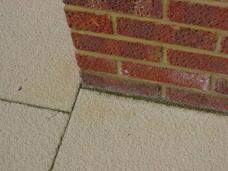Lime Mortar
 If you need help and advice with regard to structural surveys, building surveys, engineers reports, special defects reports, dilapidations, home buyers reports or any other property matters please free phone 0800 298 5424 for a friendly chat.
If you need help and advice with regard to structural surveys, building surveys, engineers reports, special defects reports, dilapidations, home buyers reports or any other property matters please free phone 0800 298 5424 for a friendly chat.
Lime every time
 Lime mortar is always recommended by any expert that you ask, for use on older properties. However, we have discovered that it is far easier said than done. Interestingly enough, we think it's probably as easy to go on a course on lime mortar, as it is to actually buy lime putty! This morning we have spent several hours hunting round for a supplier of lime putty. This is the ready mixed version of lime. Whilst hydraulic lime is available from most good builders merchants, such as Jewsons, Travis Perkins and Buildbase, getting hold of lime putty moves you into a completely different world!
Lime mortar is always recommended by any expert that you ask, for use on older properties. However, we have discovered that it is far easier said than done. Interestingly enough, we think it's probably as easy to go on a course on lime mortar, as it is to actually buy lime putty! This morning we have spent several hours hunting round for a supplier of lime putty. This is the ready mixed version of lime. Whilst hydraulic lime is available from most good builders merchants, such as Jewsons, Travis Perkins and Buildbase, getting hold of lime putty moves you into a completely different world!
Free phone 0800 298 5424
Tradesmen and lime?
Even asking the tradesmen in Jewsons, Travis Perkins and Buildbase where to get lime putty from there are mystified looks, and we were doing a demonstration of it later that afternoon it was fairly essential. We therefore looked on the Internet for lime putty, which we would recommend, and we came across Mike Wye, based in Devon , who was very helpful, but unable to deliver until the next day, a timescale that we would normally be quite happy with! Ringing round eco suppliers were the same, with a next day delivery policy. We therefore made a note that it should be lime every time, but allow 24 hours to get hold of lime putty.
 Travelling to get lime putty
Travelling to get lime putty
So it was back to the Internet to find the nearest supplier of lime putty, which we duly did, and they happened to be 30 odd miles away.
The drive to Eco Merchants to find lime putty
Ecomerchants are based in Faversham in Kent , ME13 9BU . After the disappointment of the various builder's merchants, with our bag of hydrated lime in the back of the car, we finally get to Faversham, where we meet Andrew. He gave us a great tour and we did promise to come back.
Hydrated lime

Andrew said hydrated lime used to be mixed with cement, which, in some/most people's opinion, therefore makes the lime useless, as it has the properties of lime, which doesn't work when mixed with cement mortar, and he advised that this is one of the biggest problems that they come across with architects thinking that adding hydrated lime in will give a more flexible mix.
He then showed a mixed lime that had the cement and sand already added in to it. Again, Andrew commented in a similar manner, as the cement content and properties of lime aren't really working.
Hydrated lime is for adding to cement to plasticise it and hydraulic lime is dry lime that has had a clay or a dried earth added to it, which you then add sand to use without cement. It was the hydrated lime that we were questioning just how much use is it.
Lime putty

He then went on to show us the lime putty, which comes in plastic containers. He advised the longer it cured the better it gets, saying that some of the best restorations were carried out with lime putty that is several hundreds of years old, though it's very expensive. This was available with, or without, horse or goat hair, the choice was ours! Although he advised that, typically, the lime putty with goat or horsehair in it was used for plaster.
Unfortunately, we didn't have a chance to have a good look around Ecomerchants, but we will be back, particularly as he mentioned they had been on Grand Designs TV programme several times, and there were a few stories to tell about that!
Two varieties of lime mortar
There is the 3:1 mix, used for render of brickwork. We bought two different buckets of this: one with horsehair, used for rendering and plastering and is applied in two coats, and can be applied to timber laths.
There is a 2:1 mix, used for plastering, which has silver sand in it. This is a lime mortar.
The difference between lime mortar and lime putty is that with lime putty you literally have to add the sand yourself.
The reason why someone would buy a lime putty is if they wanted to do their own special mix, but they can't just mix it in a normal cement mixer, as that just makes lime balls with sand coated on the outside. They will have to use a pan mixer, or do it by hand if they have a few days spare.
We've tried to use hydraulic lime before and it hasn't worked
Or more correctly, we supplied the bricklayers with hydraulic lime but none of them knew what to do with it, as it comes in a powder format and needs mixing and leaving for a day, which then becomes slack lime, and it also needs to be mixed in the right consistency. So, we were very disappointed to come back to our beautiful Georgian property, where we were repointing some magnificent chimneys, to find that they had all been repointed in cement mortar. The builder was even more disappointed when we asked him to take all the cement mortar out! We had a good chat with the foreman about the benefits of using lime mortar and the next week we went back to find it had been repointed in cement mortar. At this time we decided that we perhaps needed to use a different method, which is why we are presently in the car driving to buy some lime putty! We are also carrying out a demonstration of it.
Douglas Kent from Society for the Protection of Ancient Buildings (SPAB) has kindly agreed to come along and talk about lime. SPAB has an excellent website:spab.org. We recommend you go to their website and have a look around. The founder, William Morris, set out the philosophy behind SPAB, which is well worth reading about. Their technical articles are also excellent and there is one called Dealing with Inappropriate Cement Renders, which would be the sort of thing we would recommend you have a look at.
For a very modest fee we would recommend you become a member of SPAB, as they have an excellent magazine. They also issue lists of buildings in need of repair. We have now found two properties, which have made excellent projects and which have both been a cost effective exercise. We have also surveyed properties from this list, the big one that we did being Broad House.
You may also be interested in these other articles about walls and wall issues:
My property has been repointed in a cement mortar, what can I do?
Structural Cracking
How, in our experience, Insurance Companies deal with Cracks in Properties
Cracks in my Wall
Wall Tie Problems
Cavity Wall Problems
Repairing Cracks
Structural Reports
Estimating Building Costs
Cracking to my Plaster
Deteriorating Brickwork Cement Repointing
If you truly do want an independent expert opinion from a surveyor with regard to structural surveys, building surveys, structural reports, engineers reports, specific defects report, dampness, dilapidations, home buyers reports or any other property matters please contact 0800 298 5424 for a surveyor to give you a call back.
If you have a commercial property, be it leasehold or freehold, then you may wish to look at our Dilapidations Website at www.DilapsHelp.com and for Disputes go to our Disputes Help site www.DisputesHelp.com .
We hope you found the article of use and if you have any experiences that you feel should be added to this article that would benefit others, or you feel that some of the information that we have put is wrong then please do not hesitate to contact us (we are only human).
The contents of the website are for general information only and is not intended to be relied upon for specific or general decisions. Appropriate independent professional advice should be paid for before making such a decision.
All rights are reserved the contents of the website are not to be reproduced or transmitted in any form in whole or part without the express written permission of www.1stAssociated.co.uk.